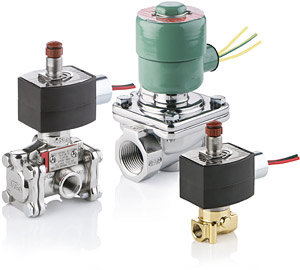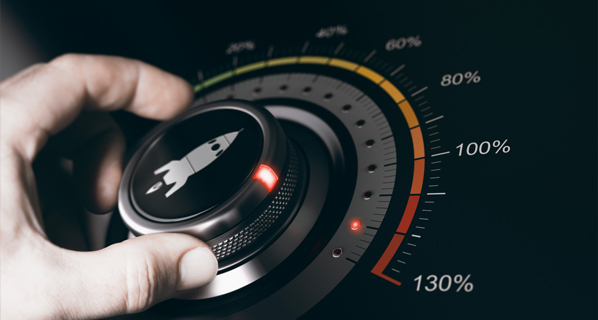Cold Hard Facts: Five Key Criteria for Selecting Low-Temperature Valves
Cold Hard Facts: Five Key Criteria for Selecting Low-Temperature Valves
by Bob Cadwell, Business Development Manager, ASCO
 Specifying and consulting engineers, engineering houses, original equipment manufacturers (OEMs), and end-users depend on valves to control the flow of compressed air or other fluids, and on cylinders to control motion. But the cold truth is that low temperatures can cause problems for these fluid automation devices all along the line — from selection and delivery to operation and maintenance.
Specifying and consulting engineers, engineering houses, original equipment manufacturers (OEMs), and end-users depend on valves to control the flow of compressed air or other fluids, and on cylinders to control motion. But the cold truth is that low temperatures can cause problems for these fluid automation devices all along the line — from selection and delivery to operation and maintenance.
Several manufacturers offer specially designed fluid automation products for environments that may experience ambient temperatures as low as -40°F (-40°C). These devices are intended for use with process valves in oil and gas, hydrocarbon, energy, refining, industrial heating, food and beverage, power, vehicular, and other applications.
Most standard models are rated for reliable operation down to only 32°F (0°C). During long, cold months in places such as Alaska, the north central U.S., Canada, the North Sea, and Siberia, fluid automation products must perform well under harsh, frigid conditions, often unattended — and frequently at remote sites that render repair or replacement more difficult than usual. Even in warmer climates, cold storage or low-temperature processing lines present special challenges for material flexibility and seal integrity. So the stakes are higher than ever when product choices are considered.
See below for the five key qualities to look for when purchasing valves, cylinders, and other fluid automation devices for application in low ambient temperatures.
1. Reliability and Reputation
Lack of resiliency/flexibility and dormancy can cause degraded performance in valves used in low temperatures.
Resiliency and flexibility suffer as temperatures drop. The elastomers in a valve disc or diaphragm depend on their resilient, elastic consistency to make a good seal with the valve seat. As they get colder, elastomeric polymers shrink — and also undergo glass transition, entering a hard, brittle, glass-like state. Both of these changes prevent consistent conformity of the disc against the seat, allowing a leak path to form.
Dormancy occurs when valves are operated at infrequent intervals (as in low-cycling applications). When a valve’s O-ring seals stay in uninterrupted contact with the body or main spool of the valve for days or even months, the seal can actually adhere against the grooves or imperfections in the metal surface of its mating components. Once operated, it responds slowly, or not at all.
Both these issues threaten reliable operation of the valve. Simple steps during assembly, such as applying high-grade lubricants that maintain serviceable consistency in the cold, can help combat surface friction. High-quality valve suppliers will also address potential problems by carefully selecting elastomers that stand up to low temperatures, as well as by designing valve seals that are optimized for frigid conditions. Dormancy may be virtually eliminated with innovative construction, such as replacing O-ring seals with new T-shaped seals, which present a much smaller surface area at the point of contact.
As with valves, cylinders used in low ambient temperatures can face their own issues.
When it comes to resiliency, cylinder seal elastomers can encounter brittleness and shrinkage, as well as different rates of thermal expansion and contraction for adjoining materials, opening the possibility of potential leak paths. The best cylinder manufacturers counter these risks by designing for minimal gap tolerances, and by selecting special cold-tested O-ring and seal materials that can retain sufficient flexibility at low temperatures.
Cylinders used in frigid conditions may face the same dormancy challenges as valves, with stick and slip problems possible for surfaces that remain in contact for long periods. To fight friction and counteract dormancy, advanced models may be permanently lubricated during assembly with carefully selected low-temperature lubricants. In addition, on critical dynamic parts, such as rod and piston seals, innovative manufacturers may incorporate special constructions, such as spring-energized lip seals.
When considering products for duty in low ambient temperatures, users must ask prospective suppliers about performance issues like flexibility and dormancy. They must also evaluate each vendor’s reputation and record of reliability.
2. Certification and Compliance
Can a given valve provide consistently safe, reliable performance in your application at -40°F (-40°C)? For example, Table 1 shows similar UL and CSA testing requirements for both general-purpose and safety shutoff valves. Both agencies include testing for endurance, valve seat leakage, and external leakage.
Beyond testing to these minimum agency standards, suppliers may go on to conduct additional tests that are not agency-required. For example, they may perform tens of thousands of added endurance testing cycles. Further thermal tests may include cycles at high and low ambient temperatures, as well as in saturated conditions, wherein the temperature of the valve and the air media put through the valve are all kept at -40°F (-40°C) for extended periods, to best simulate real-world operating conditions.
Particularly in cases where your organization is considering a new product or one from a supplier with which you have little previous history, user experience suggests that appropriate certification — or the lack thereof — should play a significant part in your purchasing decision.
3. Breadth and Depth of Offering
Many users report a strong preference for limiting their choice of supplier to organizations that offer the widest possible selection of products for low temperatures. After all, such one-stop shops provide timesaving convenience that can be important to busy planners and users. There’s only one source to specify, one contact to call, and one solution to keep in inventory.
In fact, to consolidate inventories or to meet worldwide specifications, some global companies specify certain low-ambient-temperature valves from a single source — and use them exclusively for a given application, even in warmer regions.
A provider with a wide breadth of these valves is also most likely to employ the latest technologies. These might include elastomer compounds that ensure integrity in frigid conditions, or new power-saving approaches for remote locations (see next section). A few suppliers even push the outer limits of valve technology, offering models rated for operation below -40°F (-40°C).
4. Low Temperature and Low Power
Simultaneous with the requirements for valves and other devices that will function in low temperatures have come similar needs for devices that will also work on low power. Users may simply appreciate lowering energy costs. More critically, in remote locations, such as oil and gas transmission pipelines or extraction sites, conventional valves may require heat tracing or protection. These and other power demands often necessitate larger, more costly power supplies, such as battery-charging systems or solar panels.
Therefore, some suppliers have responded with models that meet criteria both for low temperatures and low power.
Besides units that draw the least possible current at all times, some newer models feature peak-and-hold technology, which typically draws 11 watts (W) just at opening, then remains open at only 0.5 W or 1 W. Any valve well-optimized for low power may enable users to specify smaller battery banks, or run the valve longer without sunlight, or merely ensure less drain on backup generators or batteries.
However, with many valve manufacturers, the intersection of low-power and low-ambient-temperature requirements may include only a few specialized models. For ordering and stocking convenience, look for a supplier with a wider range of solutions.
5. Service and Support
Choosing the right source for low-ambient-temperature valves is often about more than just hardware. Finding a partner with the availability and support programs you need can prove equally important.
To start, look for catalog and ordering materials that are clear and easy to use. Favor suppliers with well-organized, instantly accessible configuration and online ordering. Some suppliers let users download 2D drawings and 3D models directly into their CAD software; that’s highly advantageous for OEM designers.
Explore responsiveness issues. Do valve representatives and home office technical support experts respond promptly to questions via phone, e-mail, and chat services? Do they exhibit knowledge of low-temperature issues in your particular industry or applications? If you’re part of a global organization, does the valve manufacturer match your company with robust worldwide support? Where possible, question distributors about their relationship with specific valve manufacturers.
Perhaps most crucially, consider availability. When you need a particular fluid automation device, you often need it right now. Unfortunately, many users say that availability has become a critical weak point for several manufacturers of low-ambient-temperature valves and cylinders in recent years.
Make sure the supplier you ultimately select can provide convenient local stocking and fast delivery — ideally via a quick-shipment program that publishes high on-time delivery rates.
Conclusion
Selecting fluid automation devices for service in low ambient temperatures presents some hard challenges. Users, designers, and other specifiers must give close attention to critical issues of reliability, testing and compliance, variety of selection, low-power capabilities, and support. The result will be solutions that deliver ensured performance in the colder corners of the world for years to come.
About the Author: Bob Cadwell is business development manager at ASCO. Contact him at info-valve@asco.com.







